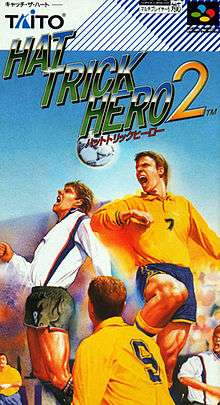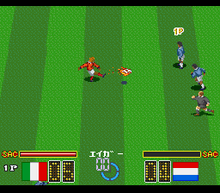Hat Trick Hero 2
| Hat Trick Hero 2 | |
|---|---|
 Box art | |
| Developer(s) | Neverland Co.[1] |
| Publisher(s) | Taito[1] |
| Composer(s) |
Yukio Nakajima[2] Yasunori Shiono[2] Takeshi Hamura[2] |
| Platform(s) | Super Famicom[3] |
| Release date(s) | |
| Genre(s) | Sports simulation[1] |
| Mode(s) |
Single-player Multiplayer (up to two players) |
Hat Trick Hero 2 (ハットトリックヒーロー2)[5] is a Japan-exclusive video game for the Super Famicom. A North American release Super Soccer Champ 2 was scheduled, however it was canceled.[4]
Summary

The game permits players to play soccer on an international level with all the national teams that took part in the 1994 FIFA World Cup, except the inclusion of Japan instead of South Korea.
Most of the text is in Japanese; including the players' surnames. Eight different players can become the captain of the player's team and the team can use one of five different formations (4-4-2, 4-3-3, 3-5-2, WM and libero).[6] All of the formations are used in modern-day soccer except for the WM formation (which saw common use in England during the 1930s). The star player (captain) chosen kicks a shot (super shot or hyper shot) that pushes the goalkeeper into the stands, just like in Hat Trick Hero. Exhibition, world league (similar to a World Cup tournament) and Taito Cup (24 teams to beat) are the three possible variations in the game. After beating all the 23 national teams in the Taito cup mode, there is a final game against a team with the abbreviation "NLC". Mode 7 graphics give the game a sense of perspective.[6]
Hat Trick Hero 2 is the sequel to Football Champ in Japan (where it was known as Hat Trick Hero), and is loosely based on the coin-operated video game Hat Trick Hero '93.[6]
See also
References
- 1 2 3 4 "Release information". GameFAQs. Retrieved 2010-05-17.
- 1 2 3 "Soundtrack Information". SNESmusic.org.
- ↑ Japanese title at super-famicom.jp (Japanese)
- 1 2 Super Soccer Champ 2 at Snes Central
- ↑ Japanese-English translation of title at superfamicom.org
- 1 2 3 "Basic game overview". MobyGames. Retrieved 2010-05-17.